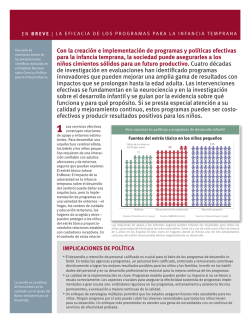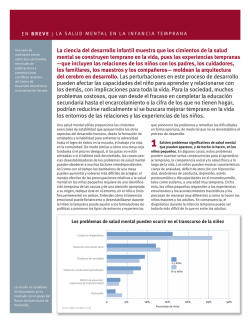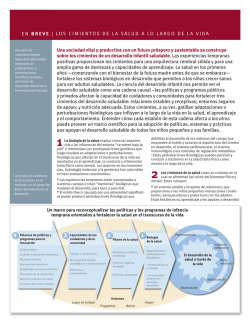
Lo que sucede en la infancia temprana puede importar a lo largo de
inbriEf | T H E I M PA C T O F E A R LY A DV E R S I T Y O N C H I L D R E N ’ S D E V E LO P M E N T EN BREVE | EL IMPACTO DE LA ADVERSIDAD DURANTE LA INFANCIA SOBRE EL DESARROLLO DE LOS NIÑOS A series of brief summaries of the scientific Una serie presentations de at the National resúmenes breves de Symposium on las presentaciones Early Childhood científicas realizadas en Science and Nacional Policy. el Simposio sobre Ciencia y Política para la Primera Infancia. What happens in early childhood can matter for a lifetime. To successfully manage our society’s future, we must recognize problems and address them before Lo sucede en lachildhood, infanciaresearch temprana puede a lo largo de theyque get worse. in early on the biologyimportar of stress shows how major la vida. Para manejar exitosamente futuro nuestra sociedad, adversity, such as extreme poverty, abuse, orel neglect cande weaken developing brain architecture reconocer and permanently set the body’systress responseantes systemde on high debemos los problemas abordarlos quealert. Science also shows that providing stable, responsive, nurturing relationships in the empeoren. Las investigaciones sobre la biología del estrés durante earliest years of life can prevent or even reverse the damaging effects of early life stress, la infancia temprana muestran cómo adversidades mayores, como with lifelong benefits for learning, behavior, and health. la pobreza extrema, el abuso o la negligencia pueden debilitar la Early experiences influence the developing with adults, he learns to cope with everyday arquitectura del cerebro en desarrollo y poner al sistema de respuesta brain. From the prenatal period through the challenges and his stress response system returns al enthe permanente La ciencia muestra questress. firstestrés years of life, brain undergoesalerta. its most rapid to baseline. Scientiststambién call this positive development, and early experiences determine Tolerable stress occurs when more serious proporcionar relaciones estables, receptivas, enriquecedoras y difficulwhether its architecture is sturdy or fragile. Durties, such as the loss of a loved one, a natural propicias durante los primeros de vidaor puede prevenir incluso ing early sensitive periods of development, theaños disaster, a frightening injury, are o buffered by brain’s circuitry most openperjudiciales to the influence of del estrés caring adults who help thecon child beneficios adapt, which revertir losisefectos temprano, external experiences, for better or for worse. During mitigates the potentially damaging effects of duraderos para el aprendizaje, el comportamiento y la salud. these sensitive periods, healthy emotional 1 1 and Las cognitive development is shaped by experiencias tempranas influyen en responsive, dependable interaction el cerebro en desarrollo. Desde el with adults, prenatal while chronic or extreme adversity periodo y durante los primeros años de el cerebro humano experimenta su For canvida, interrupt normal brain development. crecimiento más rápido y las experiencias example, children who were placed shortly tempranas determinan si su arquitectura será after birth into Durante orphanages with conditions robusta o frágil. los periodos of severedel neglect showtemprano, dramatically sensibles desarrollo los decreased del brain activity compared to children circuitos cerebro están más abiertos a la influencia las experiencias externas, para who werede never institutionalized. La negligencia extrema disminuye la fuerza del cerebro Institucionalizados bien o para mal. Durante estos periodos sensibles, el desarrollo emocional y cognitivo Chronic stress can to developsaludable es modelado porbe la toxic interacción Nunca ing brains. Learning to cope with institucionalizados receptiva y confiable con loshow adultos, adversityque is an importantcrónica part ofohealthy mientras la adversidad extrema puede interrumpir el desarrollo del child development. When wenormal are threatcerebro. Por ejemplo, los niños a los que ened, our bodies activate a variety ofpoco Fuente: C.A. Nelson (2008); Marshall, Fox y BEIP Core Group (2004). después de nacer se deja en orfanatos con physiological responses, including increascondiciones de negligencia severa, muestran brain’s activity can be measured in electrical impulses—here, es inactividad heart rate, blood pressure, and stress La The actividad cerebral puede medirse en impulsos eléctricos. Aquí, los colores una cerebral dramáticamente “hot” colors like red or orange indicate more activity, and each column “cálidos” como el rojo o el naranja indican una actividad mayor y cada hormones such as cortisol. When young disminuida, comparados con los niñosa que showsmuestra a different kind oftipo brain activity. cerebral. Young children institutionalcolumna un diferente de actividad Los niños pequeños nunca enby entornos institucionales. ized in poor conditions show precarias much less than theuna expected activity. child isestuvieron protected supportive relationships institucionalizados en condiciones presentan actividad mucho 2 menor que la esperada. POLiCY iMPLiCATiONS The basic principles ofDE neuroscience indicate that providing supportive and positive conditions IMPLICACIONES POLÍTICA l for early childhood development is more effective and less costly than attempting to address the consequences Los principios básicos deadversity la neurociencia indican que condiciones positivas de apoyo para of early later. Policies andproporcionar programs that identify and support children La versión en castellano del documento se ha realizado con el apoyo del Banco Interamericano de Desarrollo. el desarrollo la infancia temprana resulta más efectivo y menos atender las consecuenand familiesde who are most at risk for experiencing toxic stresscostoso as earlyque as possible will reduce or cias dethe la adversidad temprana la vida. remediation Las políticas yand programas con la mayor avoid need for more costlymás andtarde lessen effective supportque programs downprontitud identifican y apoyan a los niños y familias más en riesgo de experimentar estrés tóxico reducirán o the road. evitarán la necesidad de que ellos requieran más delante de programas de apoyo y recuperación, más l From pregnancy through early childhood, all of the environments in which children live and learn, costosos y menos eficaces. and the quality of their relationships with adults and caregivers, have a significant impact on emotional, social development. wide range ofcuales policies, including their Desdecognitive, el embarazo y hasta laand primera infancia, todos los Aentornos en los los niños viventhose y aprendirected toward early care and education, child protective services, adult mental health, family den, y la calidad de sus relaciones con los adultos y los cuidadores, tienen un impacto significativo sobre economic supports, and many other areas, promote safe, supportive environments and su desarrollo cognitivo, emocional y social. Unacan amplia gama the de políticas, incluyendo aquellas dirigidas stable, caring relationships thatlos children need. al cuidado y educación temprana, servicios de protección de la infancia, la salud mental de los adultos, el apoyo económico para las familias y muchas otras áreas, pueden promover los entornos seguros y de apoyo, y las relaciones estables y afectuosas que los niños necesitan. 2 estrés crónico puede ser tóxico para los cerebros ers inElthe family or community. en desarrollo. Aprender a lidiar con la adversidad Young children naturally reach es una parte importante del desarrollo saludable del out for interaction through niño. Cuando nos sentimos amenazados, nuestros babbling, facial expressions, cuerpos activan una variedad de respuestas fisiológicas, and gestures, and adults incluyendo incrementos en el ritmo cardiaco, la presión arterial y las hormonas del estrés cortisol. respond with the same oftales como abnormal levels of stresskind hormones. Whenelstrong, Cuando un niño pequeño está protegido por relaciones vocalizing and gesturing back experiences such as frequent, or prolonged adverse de apoyo con los adultos, a enfrentar los abnormal levels of stressaprende hormones. When strong, at them. In the absence of such extreme poverty or repeated abuse are experienced desafíos diarios y su sistema de respuesta al estrés frequent, or prolonged adverse experiences such as responses—or if thesu responses without adult support, stress becomes toxic, as regresa puntoabuse de partida. Los científicos extremediariamente poverty or arepeated are experienced are unreliable or inappropriexcessive cortisol disrupts brain circuits. llaman a esto estrés positivo. developing El estrés tolerable se without adult support, stress becomes toxic, as produce presentan dificultades más serias, ate—thecuando brain’ssearchitecture excessive cortisol disrupts developing brain circuits. como la pérdida de un ser querido, unlead desastre natural o early adversity can to lifelong doesSignificant not form as expected, una lesión traumática, y éstas son amortiguadas problems. Toxic stress experienced early inpor life which can leadearly toque disparities in Significant adversity can lead toa lifelong adultos afectuosos ayudan a los niños adaptarse, and common precipitants of toxic stress—such as learning andlos behavior. lo que mitiga efectos potencialmente problems. Toxic stress experienced perjudiciales early in life de prolongadas como la pobreza extrema o el abuso reiterado y el niño las enfrenta sin el apoyo de los adultos, el estrés se vuelve tóxico porque el exceso de cortisol perturba los circuitos del cerebro en desarrollo. 3 Una adversidad temprana significativa puede conducir a problemas lo largo de la vida. El estrés and mental health. The moreaadverse experiences in tóxico experimentado temprano en la vida y los precipichildhood, the greater the likelihood of developmentantes comunes del estrés tóxico —como la pobreza, and mental health. The more adverse experiences in el talabuso delays and other problems. Adultsawith more ad-el o la negligencia, lalikelihood exposición violencia, childhood, the greater the of la developmenverse experiences in early childhood are alsoomore abuso de sustancias por parte de los padres enfermetal delays and other problems. Adults with more adlikely tomentales have health problems, including alcoholism, dades de ellos— pueden producir un daño verse experiences insalud earlyfísica childhood areyalso more acumulativo en la y mental del individuo. depression, heart disease, and diabetes. likely have health including alcoholism, En latomedida en queproblems, existan más experiencias adversas depression, heart disease, and diabetes. durante la infancia, habrá una mayor probabilidad de Early intervention can prevent the consequences retrasos en el desarrollo y de otros problemas. Los of early adversity. Research shows that later adultos que cuando niños experimentaron más adversiEarly intervention can prevent the consequences poverty, abuse or neglect, parental substance abuse interventions are likely to be lessmayores successful—and los anormales de hormonas del estrés. Cuando son también los que tienen andniveles common precipitants of toxic stress—such as se dad of early adversity. Research shows thatprobabilidades later or mental illness, andadversas exposure to violence—can inde some cases areproblemas ineffective.de For example, presentan experiencias fuertes, frecuentes o experimentar salud, comowhen alcoholismo, The brain’s capacity for poverty, abuse or neglect, parental substance abuse interventions are likely to be less successful—and have a cumulative toll on an individual’s physical the same children who experienced extreme nedepresión, enfermedades cardíacas y diabetes. change decreases with or mental illness, and exposure to violence—can in some cases are ineffective. For example, when glect were placed in responsive foster care age. brain is most haveThe a cumulative toll onflexan individual’s physical the sameLachildren who experienced extreme neintervención temprana puede families before age two, their iQs prevenir increasedlas glect were placeddeinlaresponsive foster care La ible, or “plastic,” early in life consecuencias adversidad temprana. more substantially and their brain activity and families before age two, their iQs increased to accommodate a wide range Brains subjected to toxicinvestigación stress have underdeveloped neural connections in areas of the demuestra que las intervenciones tardías attachment relationships were more likely to Una adversidad significativa perjudica brain most important fortienen successful learning and behavior in school workplace. more substantially and their brainy,and activity and menos probabilidades de éxito enthe algunos of environments and interacbecome normal than if they were placed after el desarrollo en los primeros tres años casos, son ineficaces. Por ejemplo, grupo deto niños attachment relationships were un more likely tions, but as the maturing brain the success age of two. While there is no y“magic age” en sites for in school and later infue theubicado workplace que experimentó negligencia extrema become normal than if they were placed after becomes more specialized to assume more comfor intervention, it is clear that,de inlos most and community. familias antes doscases, años de the sustitutas age of two.receptivas While there is no “magic age” plex functions, it is less capable of reorganizing intervening asmayores early asincrementos possible is significantly edadfor experimentó en coeficienintervention, it is clear that, in mostsu cases, and adapting to new or unexpected challenges. For more effective than waiting. te intelectual y su actividad cerebral y sus relaciones Toxic stressas damages developing brain archi-de intervening early as possible is significantly apego se volvieron más normales que sus compañeros example, Niños con by the first year, the parts of the brain that tecture, which than can lead to life-longdeproblems in more effective waiting. retrasos en el que fueron ubicados en relationships este mismo tipo hogares Stable, caring are essential differentiate sound are becoming specialized to desarrollo learning, behavior, and physical and mental health. después de los dos años. Aunque no hay una “edad for healthy development. Children dethe language the baby has been exposed to; at the Scientists now know chronic, unrelenting stress Stable, caringthat relationships are mágica” para enessential la mayoría velop in la anintervención, environmentes ofclaro, relationships that de same time, the brain is already starting to lose the losearly casos, intervenir lo más pronto posible forque healthy development. Children de-es in childhood, caused by extreme poverty, begin in the home and include extended famability to recognize different sounds found in other mucho más que esperar. velop inefectivo an environment of relationships that repeated abuse, or severe maternal depression, ily members, early care and education providlanguages. Although the “windows” for language begin in the home and include extended famfor example, be toxic toy the developing brain. ers, and can members of the community. Studies Las relaciones estables afectuosas son esenciales Número remain de factoresopen, de riesgothese brain learning and other skills ily members, early care and education providWhilepara positive stress (moderate, short-lived physishow that toddlers who have secure, trusting el desarrollo saludable. Los niños se desarroFuente: Barth et al. (2008) circuits become increasingly difficult to alter over ers, and members of the community. Studies ological to uncomfortable experiences) llan enrelationships unresponses entorno de relaciones comienza en el with parentsque or non-parent carethat atoddlers who have time. Early plasticity means it’s easier and more hogar e incluye los destress lasecure, familia extendida, is anshow important andmiembros necessary aspect oftrusting healthy givers experience minimal hormone relationships with parents or non-parent careeffective to influence a baby’s developing brain los proveedores de cuidado yis educación, y los miembros activationtoxic when frightened a strange event, development, stress thebystrong, unrelieved givers experience minimal stress hormone de la comunidad. Los estudios en la materia demuestran architecture than to rewire parts of its circuitry in and those havestress insecure relationshipssysactivation of thewho body’s management que los bebés que tienen relaciones activation when frightened by aseguras strangey confiables event, the adult years. experience a significant activation of the tem. Inpadres the absence ofcuidadores the buffering protection of Los factores de riesgo de enfermedades cardiacas en los adultos con los owho con los no parentales and those have insecure relationships stress response system. numerous scientific adult support, toxic stress becomes built into the están implantados en las experiencias infantiles adversas experimentan una mínima activación de la hormona del experience a significant activation of the Cognitive, emotional, and social capacities are studies support these conclusions: providing estrésstress cuando se sienten atemorizados porscientific algún of body by processes that shape the architecture response system. numerous supportive, responsive relationships as early inextricably intertwined throughout the life acontecimiento extraño, y que aquellos que tienen the developing brain. studies support these conclusions: providing relaciones experimentan una in lifeinseguras as possible can prevent or activación reverse the course. The brain is a highly interrelated organ, and ___________________________________________ supportive, responsive relationships as early significativa del sistema detoxic respuesta damaging effects of stress.al estrés. Numeroits multiple functions operate in a richly coordinated For seeprevent “The Science of Early Odds in lifeinformation, ascientíficos possible can orconclusiones: reverse the sos more estudios apoyan estas ______________________________________ Ratio Emotional well-being and social compefashion. damaging effects of toxic stress. Childhood Development” and the Working Paper proporcionar relaciones receptivas y de apoyo lo antes For more information, see “The Science of Early tence provide a strong foundation for emerging posible en la the vidaNational puede prevenir o revertir los efectos ______________________________________ series from Scientific Council on Childhood Development” and the Working Paperthe cognitive abilities, and together they are the bricks nocivos estrés tóxico. see “The Science of Early For del more information, Developing Child. 3 3 3 4 4 4 5 5 5 5 4 series from the national Scientific Council on the and mortar that comprise the foundation of human Childhood Development” and the Working Paper www.developingchild.harvard.edu/library/ Developing Child.véanse “La Ciencia del Desarrollo InfanPara mayor development. The emotional and physical health, seriesinformación, from the national Scientific Council on the www.developingchild.harvard.edu/library/ til Temprano” y la serie de Documentos de Trabajo del Consejo social skills, and cognitive-linguistic Developing Child. Experiencias adversas capacities that Nacional de Desarrollo Infantil. As the number of adverse early childhood experiences mounts, Científico so www.developingchild.harvard.edu/library/ emerge inrisk theofearly years aredelays all important prerequiFuente: Dong et al. (2004) www.developingchild.harvard.edu/library/ does the developmental (top). Similarly, adult reports As number adverse of adverse early childhood mounts, to soa of the cumulative, experiences in earlyexperiences childhood correlate does risk of developmental delaysand (top). Similarly, adultthis reports rangethe of lifelong problems in physical mental health—in case, ofheart cumulative, adverse experiences in early childhood correlate to a disease (bottom). TAMBIÉN EN ESTA SERIE: THE INBRIEF SERIES: range of lifelong in physical and mental health—in this case, NGAproblems Center for EN BREVE: La ciencia del desarrollo temprano INBRIEF: The Science of Earlyinfantil Childhood Development heart disease (bottom). Best PrACtiCes EN BREVE: La función ejecutiva: habilidades la vida y el Development aprendizaje INBRIEF: The Impact of Early Adversitypara on Children’s THE iNbriEf SEriES: EN BREVE: La ciencia de la negligencia inBRIEF: Early Childhood Program Effectiveness NGA Center for Science Childhood EN inbriEf: BREVE: LaThe eficacia de of losEarly programas paraDevelopment la infancia temprana inBRIEF: The Foundations of Lifelong Health Development Best PrACtiCes THE iNbriEf inbriEf: TheSEriES: impact of Early Adversity on Children’s N aNGA tioN al C Center foro N f e r e N C e ofBest St atPrACtiCes e l e g i S l at u r e S N a t i o N a l C oN f e r e N C e of St at e l e g i S l at u r e S N a t i o N a l C oN f e r e N C e of St at e l e g i S l at u r e S EN BREVE: Los cimientos de la salud a lo largo de la vida The Science of Early Development INbriEf: Early Childhood Program Effectiveness ENinbriEf: BREVE: La salud mental en laChildhood infancia temprana inbriEf: of EarlyofAdversity on Children’s Development INbriEf:The Theimpact Foundations Lifelong Health INbriEf: Early Childhood Program Effectiveness INbriEf: The Foundations of Lifelong Health www.developingchild.harvard.edu www.developingchild.harvard.edu www.developingchild.harvard.edu
© Copyright 2024




